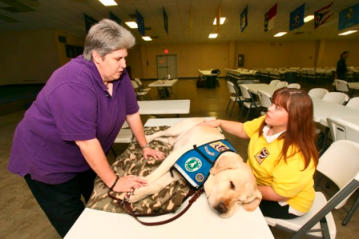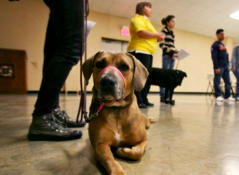

© Paws 4 Hearts Working Therapy Dogs 2014

Spring Branch business trains dogs to really be man’s
best friend
LAURA McKENZIE/Herald-Zeitung Posted: Saturday, March 5, 2011 4:48 pm Betty Taylor, For the Herald-Zeitung Herald-Zeitung Karen Minson, left, and Amanda White of Paws 4 Hearts demonstrate Tuesday how a certified therapy dog can help patients needing rehabilitation. NEW BRAUNFELS — They have long been known as man’s best friend and often answer to the name of Max, Spot or Champ. Dogs are known for their loyalty and undying love for their owners. A group of dog owners met on a recent Tuesday night at VFW Post 8315 in Schertz to build on those well-known traits of their pets and expand on them even further, hoping to train them as therapy dogs.“A therapy dog is basically a trained dog that goes out and provides services to different groups and events,” said Karen Minson, owner of Paws 4 Hearts Working Therapy Dogs of Spring Branch. “We have gone to nursing homes, Yellow Ribbon Program Events (helping military and families connect before, during and after deployments), R.E.A.D. events (helping kids with reading events) and with the Wounded Warrior Project.” A therapy dog is basically a trained dog that goes out and provides services to different groups and events," said Karen Minson, president of Paws for Hearts Working Therapy Dogs of Spring Branch. "We have gone to nursing homes, Yellow Ribbon Program Events (helping military and their families connect before, during and after deployment), R.E.A.D. events (helping kids with reading events) and with the Wounded Warrior Project." Minson and her team provide training for dog owners wishing to get their dogs certified as therapy dogs. She opened Paws 4 Hearts about a year ago, and since then, her therapy dogs have helped people in ways almost too numerous to count. “For stroke victims, for example, our dogs are trained to lie still while patients practice brushing the dog’s hair,” Minson said. “We tell them the dog’s name, and then, a few minutes later, we will ask them, ‘Now, what is the dog’s name?’” For patients undergoing physical therapy, say, on their leg, therapy dogs can get up on the table with them. The therapy dog can have his leg exercised at the same time the patient is undergoing physical therapy for his leg. Minson said the sight of a dog lying on a table having its leg exercised usually has patients laughing. “It keeps their mind off the pain,” Minson said. For some, it’s also much easier to talk to a dog than a human. Minson and her therapy dogs work with the Guadalupe Child Advocacy program in Seguin to help kids who have been abused. Dogs are non-judgmental, and they want to please. It is why they are perfect, Minson says, to serve in so many capacities as therapy dogs. During the most recent therapy dog training, Minson greeted a 14-week-old yellow lab, a Black Mouth Cur, a black lab and a Sheltie. They all seemed to follow basic commands and all seemed eager to get started with their training. The class is a once-a-week, six-week class and is open to all breeds. “We begin with an evaluation,” Minson said. “We’ve taught everything from pure breed to pure mutt.” The main thing Minson looks for during evaluation is a willingness to get the job done — both by the dog and the handler. Even dogs who were at first afraid of their own shadow have successfully passed the program. They just need to show a willingness to learn, Minson said. Dogs cannot be officially certified until they are 1 year old, but Minson suggests training them much sooner. “We can always give them the test when they turn 1 year old,” she said. Therapy dogs must stay up to date with recertification each year. For Eli and Krystal Cruz of Cibolo, it just seemed like a natural fit to train their 14-week-old yellow lab, Chunk, as a therapy dog. “We’re both military,” Krystal said. “I am a military working dog trainer at Lackland. I’m hoping he can be a therapy dog for Intrepid and Fisher House for Wounded Warrior.” Sarah Dietrich of San Antonio said she knew when she and her dog, Sahara, found each other that Sahara would be a good therapy dog. Sahara is a Black Mouth Cur. “I knew what therapy dogs were because I grew up on a therapy (horseback) riding farm,” said Dietrich, who is originally from Pennsylvania. Minson’s own dog, Chase, a 9-year-old yellow lab also wears a PTSD badge on his certification jacket — indicating he is a certified therapy dog also trained in helping those with Post Traumatic Stress Disorder. The retired champion show dog works patiently with Minson. He lies motionless on the table as Minson moves him around. She demonstrates how she moved him further away on the table to help a patient who needed coaxing out of her wheelchair for physical therapy. “What I told her was, ‘I think Chase sure would like a hug,’” Minson said. “And I think it was the first time she had gotten up out of her wheelchair in a week.” One can never know for sure, but perhaps one of Chase’s favorite parts of his job is the pet massage. What looks like a smile seems to curl from his lips as Minson gently massages his fur, explaining how important this simple act is in helping stroke victims with their physical therapy. Amanda White, part of Minson’s team, watches nearby. “What these dogs do,” White said, “is give people hope.” If you are interested in therapy dog training, visit www.Paws4Hearts.net or call (210) 325-3019. http://herald-zeitung.com/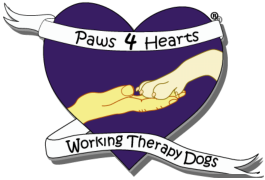
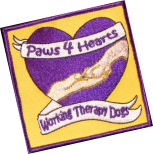
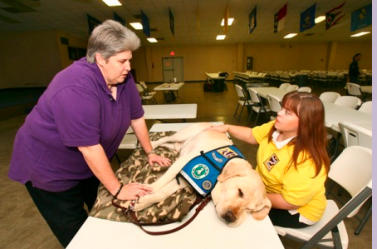
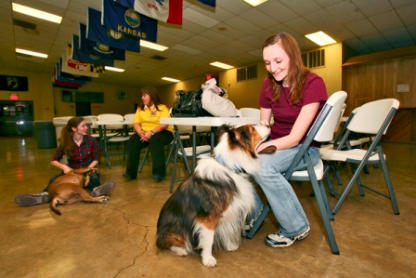
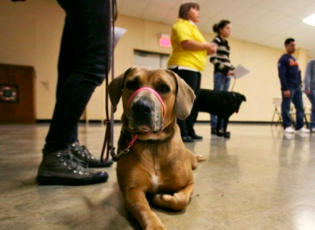


© Paws 4 Hearts Working Therapy Dogs 2014

Spring Branch business trains dogs
to really be man’s best friend
LAURA McKENZIE/Herald-Zeitung Posted: Saturday, March 5, 2011 4:48 pm Betty Taylor, For the Herald-Zeitung Herald-Zeitung Karen Minson, left, and Amanda White of Paws 4 Hearts demonstrate Tuesday how a certified therapy dog can help patients needing rehabilitation. NEW BRAUNFELS — They have long been known as man’s best friend and often answer to the name of Max, Spot or Champ. Dogs are known for their loyalty and undying love for their owners. A group of dog owners met on a recent Tuesday night at VFW Post 8315 in Schertz to build on those well-known traits of their pets and expand on them even further, hoping to train them as therapy dogs.“A therapy dog is basically a trained dog that goes out and provides services to different groups and events,” said Karen Minson, owner of Paws 4 Hearts Working Therapy Dogs of Spring Branch. “We have gone to nursing homes, Yellow Ribbon Program Events (helping military and families connect before, during and after deployments), R.E.A.D. events (helping kids with reading events) and with the Wounded Warrior Project.” A therapy dog is basically a trained dog that goes out and provides services to different groups and events," said Karen Minson, president of Paws for Hearts Working Therapy Dogs of Spring Branch. "We have gone to nursing homes, Yellow Ribbon Program Events (helping military and their families connect before, during and after deployment), R.E.A.D. events (helping kids with reading events) and with the Wounded Warrior Project." Minson and her team provide training for dog owners wishing to get their dogs certified as therapy dogs. She opened Paws 4 Hearts about a year ago, and since then, her therapy dogs have helped people in ways almost too numerous to count. “For stroke victims, for example, our dogs are trained to lie still while patients practice brushing the dog’s hair,” Minson said. “We tell them the dog’s name, and then, a few minutes later, we will ask them, ‘Now, what is the dog’s name?’” For patients undergoing physical therapy, say, on their leg, therapy dogs can get up on the table with them. The therapy dog can have his leg exercised at the same time the patient is undergoing physical therapy for his leg. Minson said the sight of a dog lying on a table having its leg exercised usually has patients laughing. “It keeps their mind off the pain,” Minson said. For some, it’s also much easier to talk to a dog than a human. Minson and her therapy dogs work with the Guadalupe Child Advocacy program in Seguin to help kids who have been abused. Dogs are non-judgmental, and they want to please. It is why they are perfect, Minson says, to serve in so many capacities as therapy dogs. During the most recent therapy dog training, Minson greeted a 14-week-old yellow lab, a Black Mouth Cur, a black lab and a Sheltie. They all seemed to follow basic commands and all seemed eager to get started with their training. The class is a once-a-week, six-week class and is open to all breeds. “We begin with an evaluation,” Minson said. “We’ve taught everything from pure breed to pure mutt.” The main thing Minson looks for during evaluation is a willingness to get the job done — both by the dog and the handler. Even dogs who were at first afraid of their own shadow have successfully passed the program. They just need to show a willingness to learn, Minson said. Dogs cannot be officially certified until they are 1 year old, but Minson suggests training them much sooner. “We can always give them the test when they turn 1 year old,” she said. Therapy dogs must stay up to date with recertification each year. For Eli and Krystal Cruz of Cibolo, it just seemed like a natural fit to train their 14-week-old yellow lab, Chunk, as a therapy dog. “We’re both military,” Krystal said. “I am a military working dog trainer at Lackland. I’m hoping he can be a therapy dog for Intrepid and Fisher House for Wounded Warrior.” Sarah Dietrich of San Antonio said she knew when she and her dog, Sahara, found each other that Sahara would be a good therapy dog. Sahara is a Black Mouth Cur. “I knew what therapy dogs were because I grew up on a therapy (horseback) riding farm,” said Dietrich, who is originally from Pennsylvania. Minson’s own dog, Chase, a 9-year-old yellow lab also wears a PTSD badge on his certification jacket — indicating he is a certified therapy dog also trained in helping those with Post Traumatic Stress Disorder. The retired champion show dog works patiently with Minson. He lies motionless on the table as Minson moves him around. She demonstrates how she moved him further away on the table to help a patient who needed coaxing out of her wheelchair for physical therapy. “What I told her was, ‘I think Chase sure would like a hug,’” Minson said. “And I think it was the first time she had gotten up out of her wheelchair in a week.” One can never know for sure, but perhaps one of Chase’s favorite parts of his job is the pet massage. What looks like a smile seems to curl from his lips as Minson gently massages his fur, explaining how important this simple act is in helping stroke victims with their physical therapy. Amanda White, part of Minson’s team, watches nearby. “What these dogs do,” White said, “is give people hope.” If you are interested in therapy dog training, visit www.Paws4Hearts.net or call (210) 325-3019. http://herald-zeitung.com/

